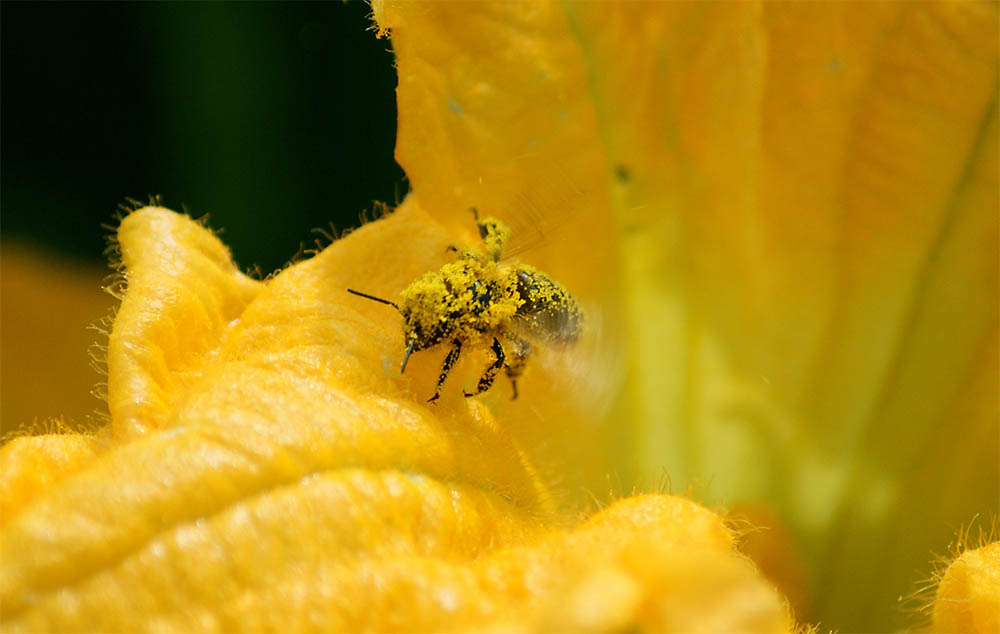
Organic Corner
By Ayanava Majumdar, Dani Carroll and Olivia Fuller
As the summer temperatures soar, insect activity in vegetable crops rises dramatically with several overlapping generations of pests feeding on crops. During this time, need-based insecticide applications may be necessary when other pest management measures like trap crops and exclusion systems are exhausted or unfeasible.
Tremendous strides have been made in the development and application of organic insecticides over the past two decades, but the issue of pollinator safety in real-world environments (not laboratory simulations) is still a vague topic. This article focuses on how to manage the use of organic insecticides around pollinators to minimize nontarget effects in specialty crops.
Common Crop Pollinators
Insects are one of the most common pollinators of crops, besides wind and mechanical movement. Insects are very efficient in transferring pollen grains to pistils. Bees are the most well-known pollinators, but there are also moths, butterflies and flies that can pollinate crops. In fact, on some days or in some areas, one may see more flies than bees gathering inside squash or gourd flowers and helping with pollination.
Planting and maintaining a flowering habitat in undisturbed corners of a farm is a good idea for conserving pollinators and beneficial insects.
Insecticide Categories
To fully understand the nature of insecticides, it is important to revisit the basic insecticide categories. The Environmental Protection Agency classifies all insecticides into four categories:
- Category I insecticides have the word DANGER on the product label and can have high nontarget effects.
- Category II insecticides have WARNING on the label.
- Category III insecticides have CAUTION on the label.
- Category IV are some of the safest products with low nontarget effects.
Long ago, there were organic-approved insecticides that were Category I poisons, but those have been removed from all crop use. Most organic insecticides in the market today are Category III and IV products with minimal nontarget effects when used per label instructions. Remember: The label is the law!
Insecticide Selection
Look at the label and check out the mode of action and selectivity of the insecticide to the target pest. Bacillus thuringiensis or Bt-based products (e.g., DiPel, XenTari) along with other microbial insecticides like nuclear polyhedrosis viruses (e.g., GemStar) and fungi (e.g., BotaniGard, Met52) have a specific mode of entry and infection process that make them very friendly to pollinators and beneficial insects.
Certain nonselective insecticides, like kaolin clay and insecticidal soaps (Category III), can be softer on pollinators but can desiccate or drown small pollinator species like flies. In general, insecticides with spinosad and natural pyrethrin as active ingredients affect a very broad range of pests and life stages making them toxic to bees and smaller pollinators. Following targeted application and correct dosage can help reduce risk.
Application Advice
As a general rule, never apply any insecticide (selective or otherwise) directly over pollinators and other beneficials. Always calibrate your sprayer to apply the correct insecticide dosage and check the nozzles.
Apply insecticides during the evening hours (close to dusk). This is when the plants cool off after a hot day and pollinators like bees go back to their hives. Check blooms of plants with large flowers, like cucurbits, for pollinator activity. Evening applications also let the spray solutions dry out on plant surfaces, allowing significant reduction in toxicity to pollinators. Rotate nonselective insecticides with selective ones to allow natural enemies and pollinator activity to rebound.
Other Recommendations
Specialty crop producers should scout weekly or more often and keep records of pest infestations.
To stay updated on integrated pest management research and pest alerts in Alabama, subscribe to the Alabama IPM Communicator E-newsletter (aces.edu/ipmcommunicator).
Use the Farming Basics Mobile App to identify common insects, connect to beginning farmer resources and to contact a commercial horticulture regional Extension agent in Alabama.
Ayanava Majumdar is an Extension professor at Auburn University. Dani Carroll and Olivia Fuller are regional Extension agents for the Alabama Cooperative Extension System.









